One way to develop your understanding of the tarot is to look at how the four elements — earth, air, fire and water — play out in the cards. You’ll see symbols of these four elements popping up all over the place in many tarot decks, and learning to spot these visual clues can really help you to understand the nuances of a card’s meaning, and develop your own interpretations too.
To me, earth, air, fire and water represent four different aspects of my self — physical, intellectual, energetic and emotional, respectively. In this article I want to show you how to relate these elements to the four suits in the tarot, and to spot elemental symbols throughout your tarot deck.

The alchemical symbols for the four elements of earth, air, fire and water
There are plenty of approaches you can take here. Some people add a fifth and even a sixth element to this system, others work with an entirely different set of elements. Here I’m just focusing on the four ‘classical’ elements that I use in my own tarot practice.
Also, I’m aware that every deck is different and some depict the elements far more than others. If you use a deck like the Wild Unknown, for example, you might struggle to find elemental symbols, whereas others (like the Rider Waite Smith or the Shadowscapes I’ve used throughout this post) are rich in visual clues.
The Minor Arcana
The best place to start understanding the elements in tarot is by linking the four suits of the minor arcana — so that’s the wands, swords, cups and pentacles cards — to their corresponding elements. These 56 cards are all about day-to-day life: the stuff we go through as living, breathing, interacting humans, the things we create, the things we feel, the things we think, the things we do.
Each of the four suits in the minor arcana corresponds to one of the four elements, like this:
Pentacles = Earth | Cups = Water
Swords = Air | Wands = Fire
Below I’ve given a few examples to show how the elements are used and illustrated in a brief selection of tarot cards. The aim here is not to give any definitive guide to these cards’ meanings (you’ll probably have your own ideas about these, which I hope you’ll share in the comments!) but more to get you looking at your own cards through this lens.
Earth
This is your physical self. So the element of earth represents my body and health, my sex life, my physical surroundings and my relationship with nature and the built environment, and other ‘practical’ areas of my life – crafts, work, money. Earth is tangible, weighty and real – I can hold it in my hands or experience it via my senses.
Similarly, the suit of pentacles in tarot represents these physical areas of our lives, and you may see lots of seeds, fruit and trees in these cards, as well as mountains, buildings, marketplaces, gardens and so on.
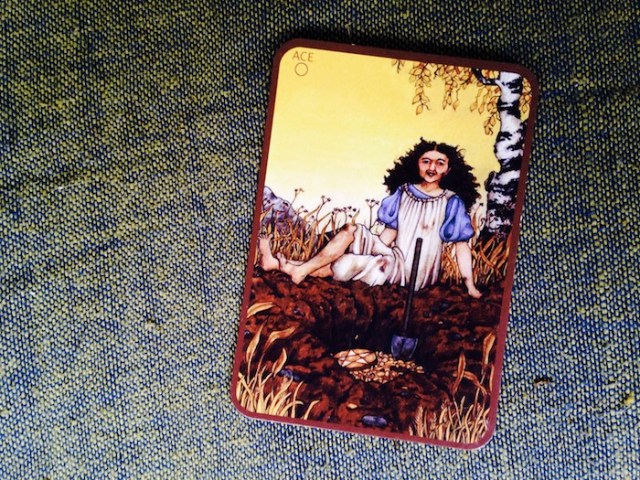
The Ace of Pentacles, from the Anna K Tarot by Anna Klaffinger
As the first card in the Pentacles sequence, people often say that the Ace of Pentacles represents a new job, an improvement in your health, or it might suggest moving house. These are all ‘earthy’ areas of our lives, so the Ace is like a seed from which something beautiful may grow. In the Ten of Pentacles we see a close-knit marketplace with lots of people, buildings and buying and selling, representing a high-functioning community (in capitalist terms, at least).
The Seven often has a gardening theme. There’s this real earthy metaphor of taking stock of your work so far, seeing your efforts beginning to bear fruit. I love this gorgeous version from the Shadowscapes Tarot:
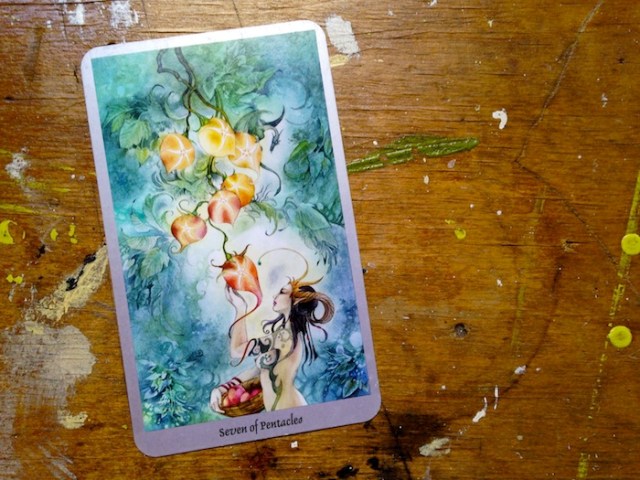
The Seven of Pentacles, from the Shadowscapes Tarot by Stephanie Pui-Mun Law
The Five of Pentacles often feels like sexual rejection to me — literally being ‘out in the cold’ rather than wrapped in hot sheets — whilst the Page, holding up a pentacles in that flirtatious way, could be an adventurous new bedfellow who wants to teach you something new.
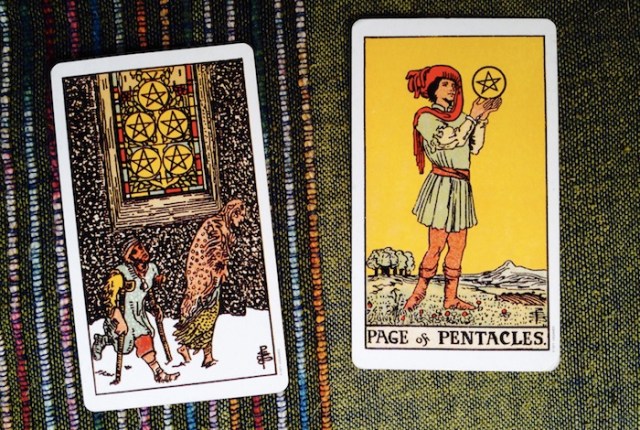
Five and Page of Pentacles from the Rider-Waite-Smith Tarot
Water
This is your soulful, emotional self; your feelings and your intuition. Water has flow, right? Sometimes it’s an uncontrollable torrent, sometimes more of a dried-up trickle. Sometimes it’s a running river, sometimes it’s blocked up by a dam. It’s the inexplicable, the irrational, the stuff that comes straight from your heart and flows in all kinds of directions (whether you want it to or not).
The cards in the suit of cups tend to represent the way our feelings play out. Look for watery clues such as rivers, oceans and fish. Where are they placed in the cards and what are they doing? If there are people in the card, how are they responding to the water?
The Ace could be a new love, or the start of a new emotional ‘era’, like your heart has turned a corner. Then the next card, the Two of Cups, often shows the heartfelt exchange of feelings between two people. In this version two women are literally offering each other full cups of water/emotion, sharing their hearts. That could be romantic, or it could be the beginning of a beautiful friendship, the point is that in offering their cups, each is saying “I want to be emotionally open with you.”
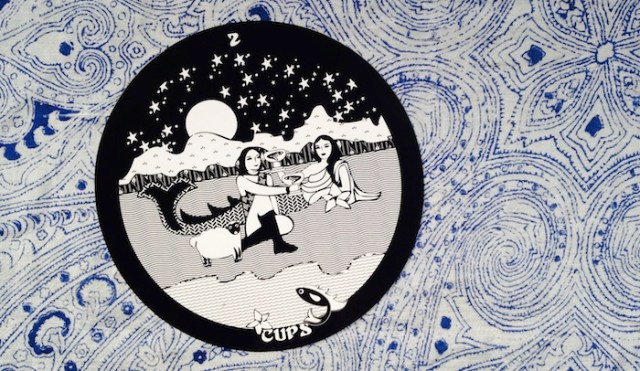
The Two of Cups, from the Gorgon’s Tarot by Dolores Fitchie
To me, the Queen of Cups is the minor arcana’s answer to The High Priestess, a deep and intuitive, witchy character with her feet in the water, whereas the Knight of Cups, gazing at their cup as if it is the only thing that matters, is that obsessive lover you can’t shake off.
The Five of Cups could illustrate a period of ‘processing’ something painful — check out the water flowing under the bridge — and the Eight, knowing it’s time to turn your back on old feelings and walk away.
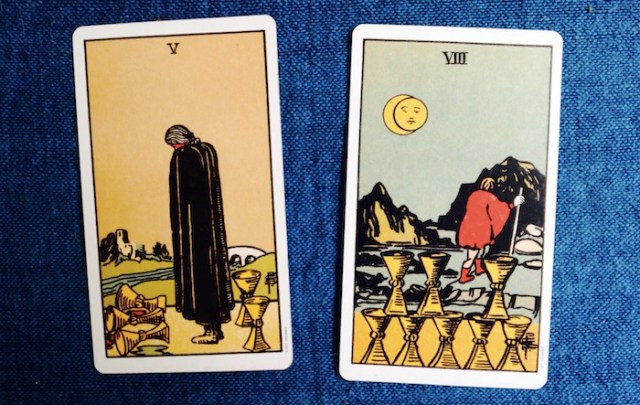
Five and Eight of Cups from the Rider-Waite-Smith Tarot
Air
This is your intellectual self — your thoughts, your sense of right and wrong, the stuff that goes through your head and your ability to strategise. In its best form, it’s when you climb to the top of a mountain on a clear day, breathe in that clean, fresh air and check out that wide-ranging view. In this sense, air can be pure, beautiful truth.
Huh. If only it was always like that! As fallible humans, our minds torment us. The suit of swords is often known as the ‘suit of sorrow’, because of the way we so often are victims of our own thoughts and insecurities. In the Eight of Swords, for example, we often see a figure ‘penned in’ by a prison of swords — as in, her thoughts are keeping her captive:
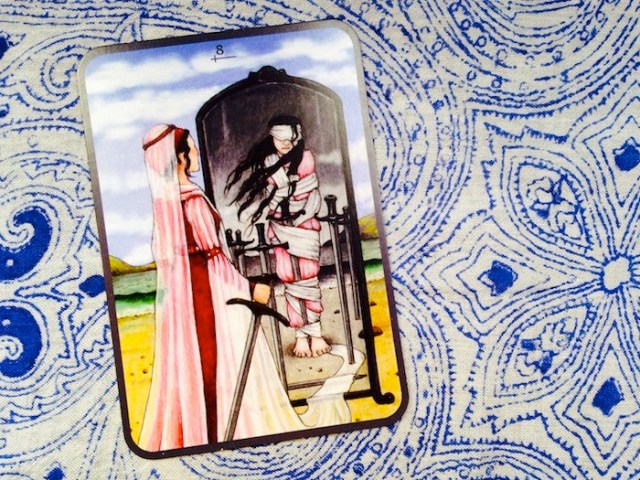
Eight of Swords from the Anna K Tarot
Another ‘airy’ clue to look out for is the sky. Is it clear or cloudy? Blue or black? What might that mean in terms of a person’s mental state? In the card above, the sky is actually clear and blue, but the woman looks into a mirror and sees only grey clouds and gloomy thoughts.
In the cards below, the Knight of Swords dashes single-mindedly at an idea…but the stormy sky says his judgement may be clouded. Meanwhile, the Queen sits high above the clouds where the air is still and clear; a single bird flies above her head, surveying the ground below.
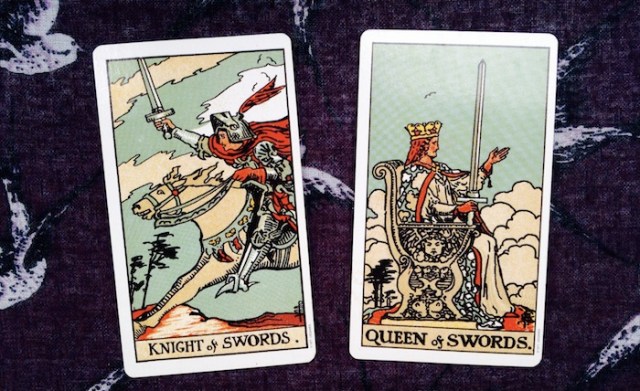
The Knight and Queen of Swords from the Rider-Waite-Smith Tarot
The Six of Swords is an interesting card. In some decks, we see a figure leaving swords behind on the bank of a lake, in others, they take the swords with them in the boat. If swords are symbolic of our difficult thoughts, what might it mean in either case? Also notice that the two people are in a boat, crossing a body of water. So there is an emotional element to this card: these people are symbolically traversing a choppy emotional sea. How do you think that air and water work together to convey this card’s meaning?
The same can be said for the Two of Swords. Here, a person guards themselves with their swords, putting up a strong mental boundary. They are claiming time to think, and they clearly want to do it alone. Again there is water in this card, a very calm-looking sea of emotion in the background…which the person is willfully ignoring.

The Six and Two of Swords, from the Gorgon’s Tarot
Fire
Fire is the most primal of the elements. It is our passion and drive, the spark that gets us all fired up, the inexplicable reason why we do the things we do, the starting point for…pretty much everything! It’s also about confidence and, of course, ego. Look for sunshine, flames, sunflowers, lightening and flounces of red, yellow and orange — anything bright, bold and possibly dangerous — to represent fire in your tarot cards.
Correspondingly, the suit of wands is all about ideas and projects, risk-taking and strong personalities. The Knight of Wands is a favourite of mine. Charismatic and untamed, she’s obviously got a great idea and she wants to show it off. I know when I see this card that I might need to get my ego in check (pride comes before a fall and all that) but in the moment, it’s pure confidence and fun. The ‘flames’ of her tunic and her horse’s mane all shout “look at me, I’m fabulous!” And yet, there is no sign of water in the card, and the earth she rides through is a dusty, barren desert. The feeling I get is that there is waaaaay too much fire here, completely untempered by intuition (water) or earthy realism.
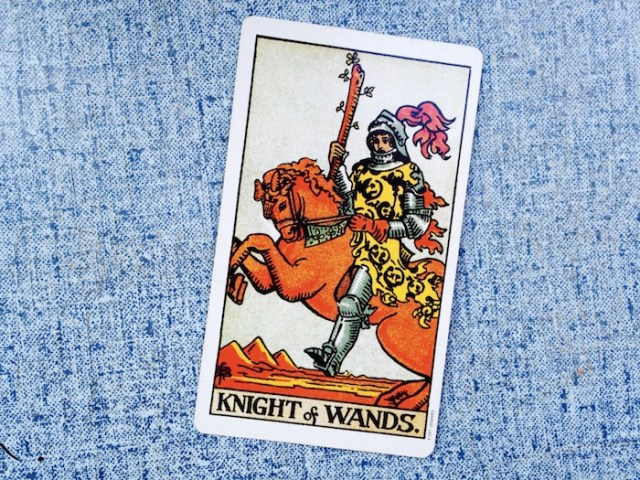
The Knight of Wands from the Rider-Waite-Smith Tarot
The Ace might represent a new project or a brilliant idea. It’s the striking of the match, that sparky moment when you know you want to do something. Next in sequence you have the Two and the Three of Wands, which to me represent the process of really forming that idea into something possible.
Take these cards from the Shadowscapes Tarot. In the Two, although a fiery sun beats down, this person is very still. There is the element of air here — the person sits in a high place, quietly surveying the view…they are still thinking about how to bring their idea to life. By the time we reach the Three, they are standing and seem ready to act, and now we can see all four elements present. The earth, represented by the ground below, the fiery sun still hight in the sky, the river winding its way through the landscape and the breeze lifting the figure’s cape.
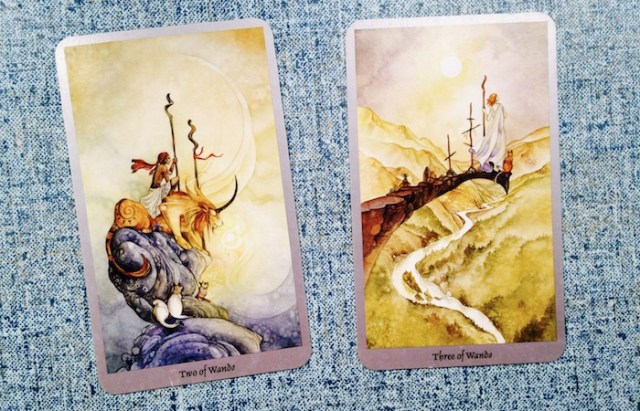
The Two and Three of Wands, from the Shadowscapes Tarot
These are just a few examples using the cards I have at hand. Dig out your own tarot decks and check out the elemental symbols in your cards! Try looking for all four elements in cards from every suit, not just air in the swords cards or earth in the pentacles. Look also at which elements are missing, and whether this is significant. And think about how the elements interact with each other, like the air and water in the Two of Swords I mentioned above.
Of course, all of this is without even mentioning the major arcana, where the elements come through in even stronger and more complex ways. If you’re feeling confident, you could also turn your attention to the majors and look at how symbols of the suits and elements crop up here too.
Over to you! How do you view the elements within (or separate to) your tarot practice? Do you use an entirely different set of elements? Which cards to you seem to have strong elemental correspondences?



I’ve been following Stephanie Pui-Mun Law’s art since Elfwood was a thing…amazing to see her tarot out in the world!
Wow! The Shadowscapes was the first deck I got when I realised that tarot wasn’t *only* the RWS deck… at first I was so not into the fairies and pastel colours…but I kept finding myself going back to her website over and over, poring over those details. A slow-burning love :)
I don’t know what Elfwood is though…
It was a proto-Deviantart, for scifi and fantasy art, with curated galleries. It wasn’t actually hard to get a profile, but it was the THING when my friends and I were little dragon-and-fairy doodling beginner artists.
Aww, that’s so cool! I love the dragons in this tarot deck….
I find elemental associations to be the most helpful way to remember the meanings of tarot cards. I’m still finding my feet with the Tarot of the Silicon Dawn, though – the creator Egypt Urnash swapped Wands and Pentacles around, so Wands = Earth and Pentacles = Fire. Her reasoning is: ‘the bounty of of the Earth seems a much better association for the Wands than the Pents to me, especially when the wands are so often depicted as flowering’ (p. 21 of her guidebook). So a lot of the card meanings for these two suits are quite different to most decks, and I think it’s a really interesting take on them.
Oh wow Gil, that’s gonna mess with my head! I just got the Silicon Dawn tarot but haven’t had a proper play yet. I can see what Egypt Urnash means.
So interesting how people interpret/FEEL the elements differently. I had always thought of fire as being the ‘highest’ element – above the ‘exhalted’ air, like the sun, but a tarotist friend of mine talked about how it is the most basic, like the core of the earth – without fire, there’s nothing. Her feelings make a lot more sense to me.
I just started the Minor Arcana section of Rachel Pollack’s Seventy-Eight Degrees of Wisdom, and this is exactly what I needed to complement her wonderful, but more complex and heady, descriptions of the suits. I’m finding it really helpful to use the four elements like this in my understanding, but even so I’m still trying to get my head around most of the suits. Cups/water was by far the easiest and most intuitive for me to grasp. Despite being familiar with each of the individual swords cards at this point, I’m finding them the hardest suit to “get.” From a purely intellectual standpoint, there are some cool things about the suit and its relation to air – I’m a soon-to-be-psychologist, and the science I know/use on thinking and language (RFT, on the off chance anyone else is familiar with it) ties in here is some neat ways. But I still struggle to get a coherent sense of what is up with the suit more generally.
A final note – I’m cracking up as I realize that I just wrote that I got Cups “intuitively” but only understand Swords from an “intellectual” perspective.
I’d love to see a psychologist’s take on the swords cards!
I know what you mean about this suit being extra-tricky Jane. One thing that really helped me to get going with the swords was to think of the actual swords in the pictures each representing a thought. So… is it a negative though? A clear, beautiful, true thought? An insecurity?
Seventy-Eight Degrees of Wisdom can be heavy going but it’s my favourite tarot book. I think Pollack can be a bit gender-essentialist at times but it really helped me to learn tarot :)
I love the idea of thinking of the actual swords as thoughts – that is super helpful! It really quickly and beautifully resolves the difficulty I was having reconciling the various thought/intellect/truth/clarity/pain/conflict themes in Swords into one more overarching theme.
I agree about the gender essentialism – I kind of expected that I’d encounter it in any tarot book, though. I have to say, I was happily surprised that she does explicitly note that it’s society’s perceptions of male/female she’s referring to in some places. I also kind of dig her explanations of how cards like the High Priestess have a “scary” and “mysterious” quality not because those things are inherent in femaleness/femininity, but rather because of patriarchal views/biases.
I’m hankering to write more at length about psychology and tarot (maybe in my tarot journal, or I’m thinking of starting a blog), but to give a quick run-down of swords/air/thoughts for now: RFT is a science of human language and cognition that comes from behaviorism, and therefore has a unique and (I think) extra-science perspective. One of the implications of RFT findings is that the human capacity for thought is a “double-edged sword.” It can help us problem-solve and plan and do all sorts of wonderful things, but it is also one of the most potent sources of our suffering. It takes the regular, inevitable pain that we are bound to encounter in life and adds to it, prolongs it, makes it more “sticky.” Thus, the painful aspects of the Swords suit.
The funny thing is, even though thoughts are very powerful in this way, and even though they can feel so REAL at times, they aren’t truly real at all – they are just series of symbols or sounds, with no inherent meaning. In one therapy exercise (which I rarely use because it’s weird and usually irrelevant), you say the word “milk,” notice all the thoughts, images, even sounds & tastes that it evokes, and then say “milk milk milk” over and over again rapidly for a minute or so until the word loses its meaning and just sounds like a weird noise in order to demonstrate this. In another, only slightly less bizarre exercise, you get up and walk across the room while saying “I can’t walk! I can’t walk!” to illustrate the point that thinking something doesn’t make it true, and doesn’t necessarily have to influence your behavior. This is where I see thoughts as being like air. They can be forceful, and can push you around; they can play tricks on you (mirages, fog, clouds…); they can make insubstantial things seem real (again, clouds); and yet, they’re not at all concrete, not real. You can put your hand right through them and you won’t feel anything at all.
Also: once you’ve got cognition, you’re pretty much stuck with it forever (barring serious brain injury), for every second of your life. It’s literally omni-present. And yet, precisely because it’s so pervasive, we usually don’t notice that it’s there at all. JUST LIKE AIR, guys. I get so excited getting to be nerdy about this stuff!